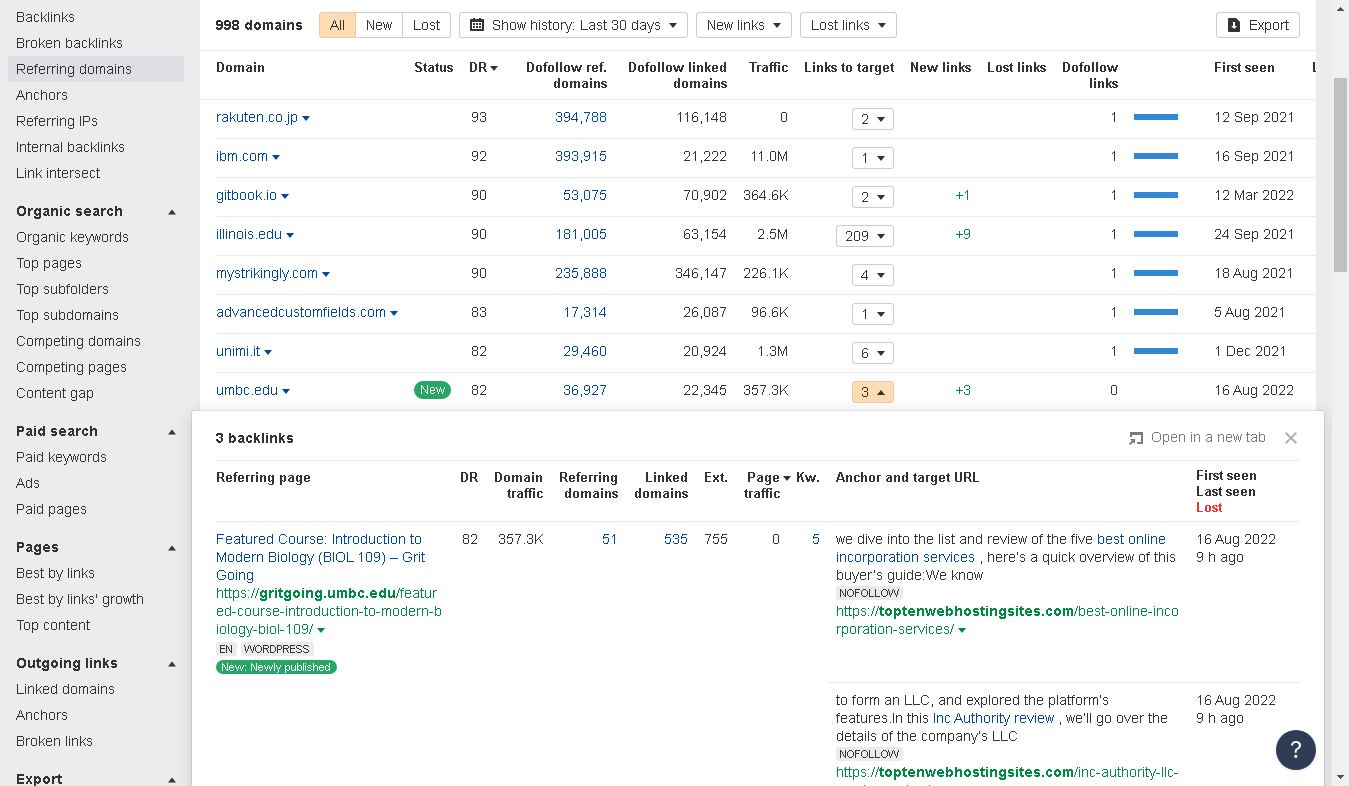Once you have found expired (or aged) domains for your 301 redirects or new websites, you need to perform due diligence on the expired domains. You don’t want to associate a spammy domain with your site, as doing so could hurt your search engine rankings and may even result in a Google penalty.
Doing due diligence on expired domains involves looking at the domain’s backlink profile, as well as looking at what was previously on the domain. This article is a guide on how to perform proper due diligence on expired domains to ensure you don’t hurt your site or waste money.
Table of Contents
- Introduction
- Quick high-level due diligence on expired domains
- In-depth backlink due diligence research
- In-depth keyword due diligence research
- Historical content due diligence research
- Download the Website Investing Beginner’s Kit FREE
- Key points
Introduction
301 redirects using expired domains are a great way to boost your site’s authority and thus its organic traffic. But finding good expired domains that qualify for this can be difficult. First, you must be able to search for domains in your niche that meet your specifications. And after that, you have to perform due diligence to ensure that the domains are actually worth buying.
The due diligence step is vital, because there are penalties for using the wrong domain. A domain that Google thinks is spammy can result in lower rankings, or worse, a manual action. But even domains that aren’t actually spam can be a waste of money if they don’t have a useful backlink profile or content history.
So in this article, I will walk you through my process for doing due diligence on expired domains.
Quick high-level due diligence on expired domains
The first thing I do when looking for expired or aged domains is follow the steps here. These help narrow down domains that may be of interest to a short list. However the short list may have dozens of items, so I need another step to filter out the bad ones.
I do this using the free Website SEO Checker. This tool is very easy to use and quick, and can take multiple domains at a time. Since there’s a limit to the number of domains you can check, I copy and paste a few at a time and then run the tool.
The tool returns a report like this one:
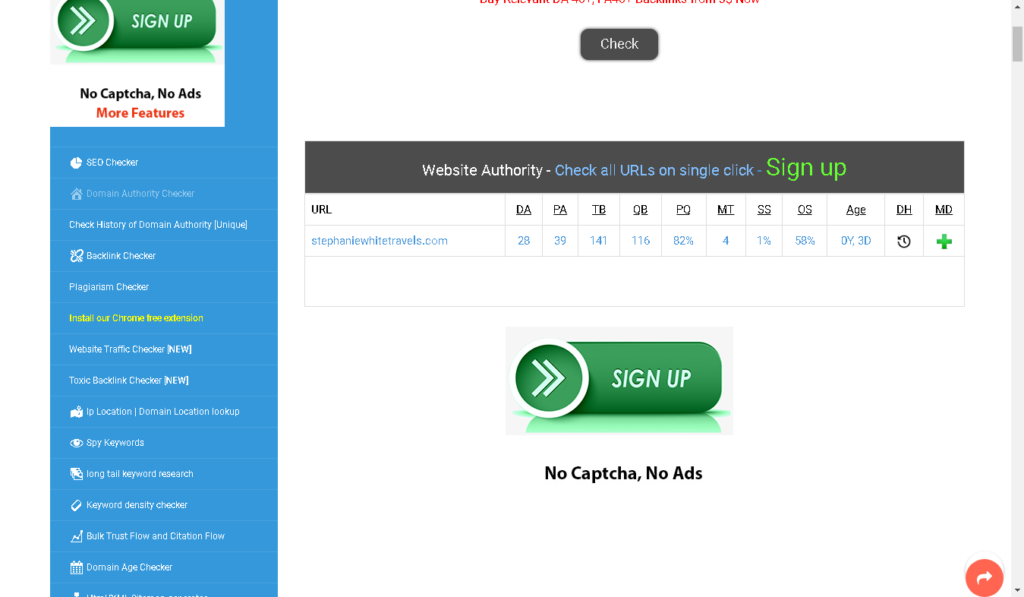
Understand the Website SEO Checker results
The results provide a reasonable amount of information quickly:
- DA – The domain authority from Moz. This can vary greatly compared to Ahrefs or Semrush.
- PA – The page authority from Moz. It’s not particularly important for the purposes of this article.
- TB – The total number of backlinks to the domain (according to Moz).
- QB – The number of quality backlinks to the domain.
- PQ – TB/QB, or the percentage of quality backlinks to the domain.
- MT – The MozTrust score, which is a proxy for whether the backlinks are from trusted sources.
- SS – The spam score, based on the content of the site. This is not important for our purposes, since there’s no longer content on the site.
- OS – This is the Off-page SEO score from Moz, and it includes several factors including social links, domain mentions in the news, clickstream data and more.
- Age – The age of the domain, according to the tool. This isn’t the time that the domain was actually in use, so it’s worth looking at the history on archive.org.
When doing high level due diligence on a set of expired domains, I mostly look at DA and PQ. If DA is over a certain value (depending on the site you’re trying to link to) and PQ is over 90%, I put the domain on a shortlist to look into more using Ahrefs or Semrush.
The age and total backlinks are also relevant, but we will look at those more closely later. At this point we just want a list of potential domains to look at.
In-depth backlink due diligence research
Once we have a shortlist of expired domains that we are interested in performing due diligence on, we can move to a more comprehensive tool like Ahrefs or Semrush.
Evaluate referring domains
To get started, log in to your favorite tool, and run a referring domains report:
I like to sort the report by domain authority, so I can quickly see what the top quality backlinks are. Unless I’m doing this for an esoteric topic that doesn’t have a lot of content written on it, I only buy domains with at least a couple of top quality backlinks.
What do I mean by “top quality” backlinks? I mean backlinks from well known publications that most people online would be familiar with. Examples are insider.com, bbc.co.uk, techcrunch.com, EDU or government sites, and fool.com.
If I do find “top quality” backlinks, I dig a bit deeper. First, I check the actual pages on those sites to ensure that the link still exists and is in the main content — links from comments or in some user generated content are useless.
Next, I go through the full list of referring domains, sorted by domain authority, and look for referring domains that appear spammy or inorganic. There are several patterns that I make note of:
- Multiple subdomains of blogspot.com (or another blog platform), which often signal auto generated spam sites
- Multiple random letter domains, which are often bulk spam
- A large number of foreign backlinks (outside of wherever the domain is), especially ones in different languages
It’s important to note that most domains will have some of these — we’re looking for a large amount of any of the spam patterns above.
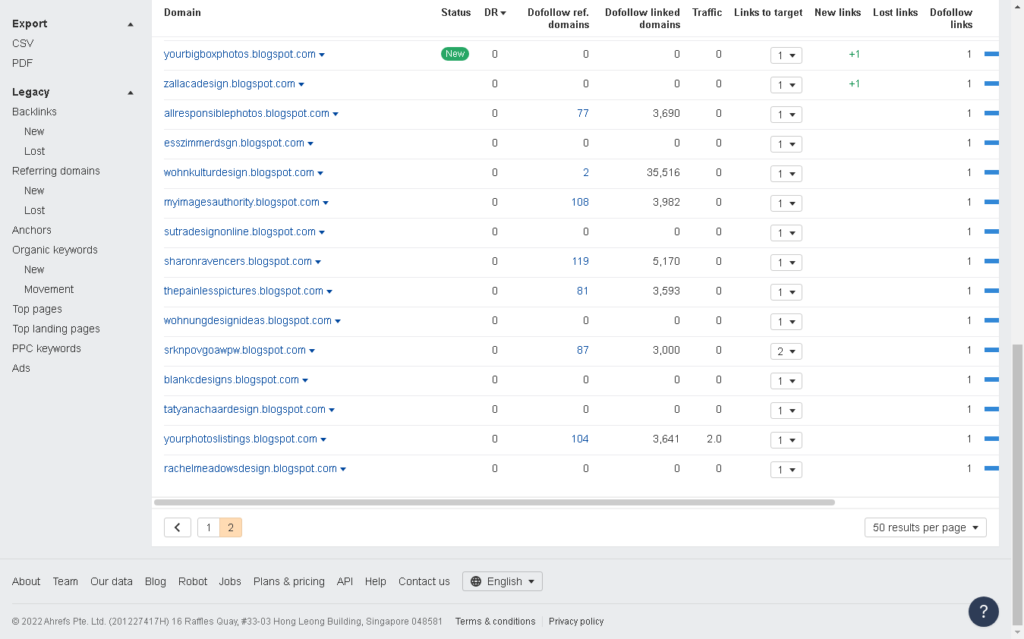
Evaluate linked content
Now, it’s time to look at the linked content, in order to determine whether it’s real or spam. I tend to do this with both the high DA referring domains and the lower ones, since either could be spam.
In Ahrefs, you can click on the down arrow in the Links to Target column to see the links. When evaluating the high DA links, look for comment spam or other content that should not be on the site. A good example is below:
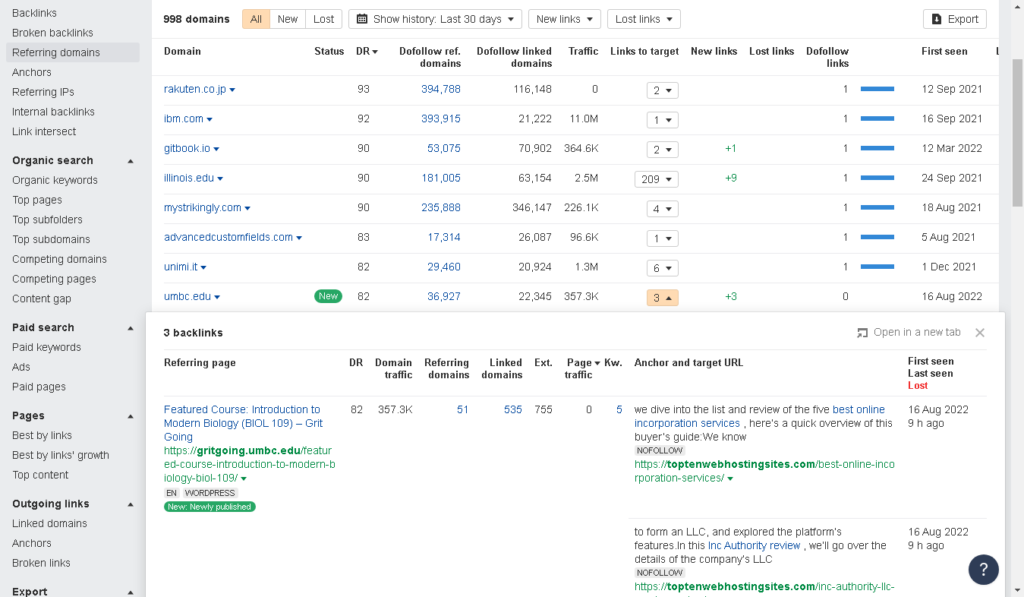
The domain in the screenshot above is a good example of why it’s necessary to look through the content of links even from top quality domains. This domain has backlinks from several .EDU sites, which should make it valuable.
However, if you look more closely at the content linked, you will see that the person who ran the domain found unsecured pages on those .EDU sites and posted spam there. Interestingly enough, Google later caught on to that trick and the site plummeted in the rankings.
In addition to the high DA referring domains, it’s important to check the lower DA referring domains. These are more likely to contain spam, although that’s common, and it’s hard to find any domain these days without some spam links.
Nevertheless, you don’t want spam backlinks to make up a significant portion of the links to the domain.
In-depth keyword due diligence research
If the domain passes the backlink due diligence tests, it’s time to look at the keywords that the domain has.
Many domains will have no keywords, so there is nothing to investigate here — in the next section we will look at the content that was on the domain to get a sense of what the keywords may have been.
Some domains, however, will have keywords that they rank for still. So it’s important to look at these and account for them in valuing a domain. In Ahrefs or Semrush, go to the Organic Keywords report.
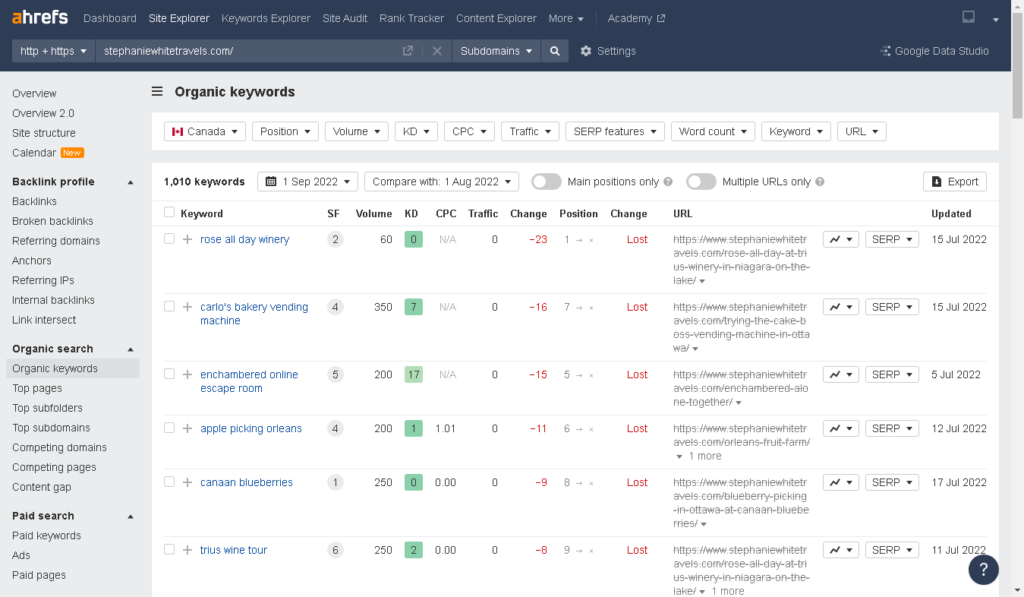
If the domain has non-spam keywords, that’s great! Those keywords may remain when you redirect the domain to your site, which is an bonus for you. But often these domains — if they do have keywords — have spam or explicit keywords. If you find these, then don’t purchase the domain.
Historical content due diligence research
If the domain still has keywords that it ranks for, then you have a reasonable idea of what content was on it. But if it no longer ranks for any keyword, then you need to look carefully at the domain’s content history in order to understand whether it’s worth purchasing.
How do you find the domain’s content history? You can go to archive.org and look it up in the Wayback Machine. This gives you a sense of what the content on the domain was, as well as how long the domain was in service (older domains are more trusted by Google).
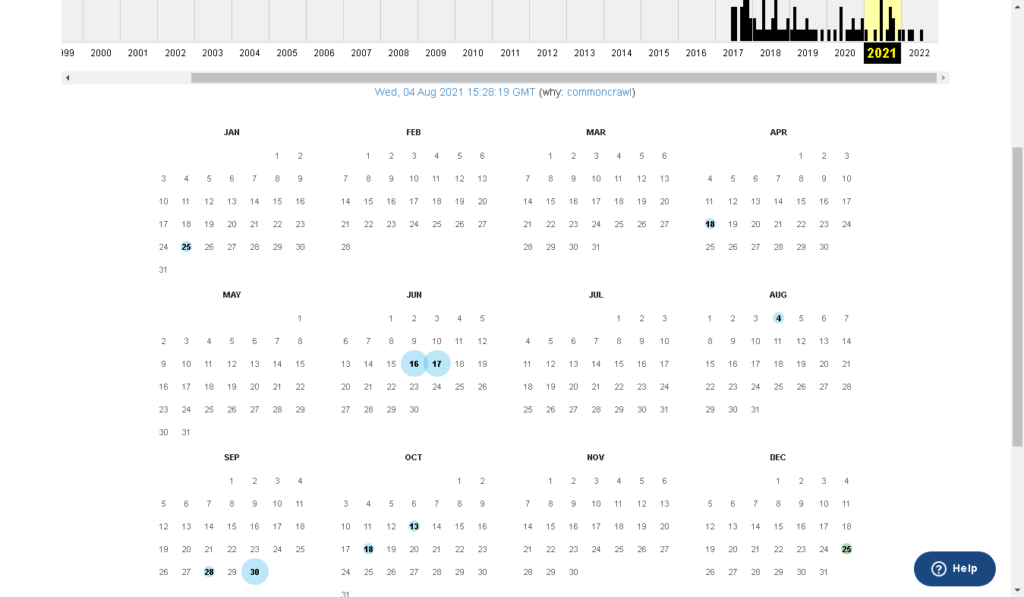
You can look at the content at any of the dates highlighted. It’s best to look at the most recent and oldest. If the domain did get dropped and picked up by a spammer, the most recent archive will generally show this.
Older archives should show the content that actually got the backlinks, so you should peruse those old archives as well.
The important things to determine when looking at content are: 1) is the content spam, and 2) is the content relevant (preferably, very relevant) to the content of the site you want to redirect the domain to. If the content is not relevant, redirecting the domain to your site won’t be of much use, and may actually be a bit hurtful.
The extent to which the content must be relevant is somewhat of a gray area, but you don’t want something that’s totally irrelevant (like auto repair content for your cooking site). If you’re not sure whether the content is relevant, you can go to an AI summary tool which will spit out keywords for content, and then see if you want your site to rank for those keywords.
Download the Website Investing Beginner’s Kit FREE
If you’re looking at a website to purchase, my Website Investing Beginner’s Kit is crucial. It includes due diligence and valuation worksheets, free access to my website screener tool, as well as tools to help you get started in the business.
And it’s available FREE — all you have to do is join my mailing list below. Along with great website investing content and tips, you’ll get the entire Website Investing Beginner’s Kit delivered to your inbox.
Key points
Once the domain you’re looking at has passed the in-depth backlink and content due diligence, it’s e to determine how much you’re willing to spend for the domain.
There are two ways to do this:
- If you’re willing to look at the domain as an investment separately from your site, you can look at real world prices (at auctions) and buy it based on how much you could resell it for in the future. This is my preferred way to go about purchasing expired domains.
- You can value it based on the ranking increase you would get on your site. For an established site, this is would generally be less than the former valuation, so you may have trouble getting the domain at this price.
I prefer to look at the expired domains as a standalone investment, with the added benefit that they increase search rankings for my sites. That way I can put in competitive bids when trying to purchase in demand domains at auction.
In the end, how you value these domains is up to you. And if you have any questions, feel free to contact me for help!

